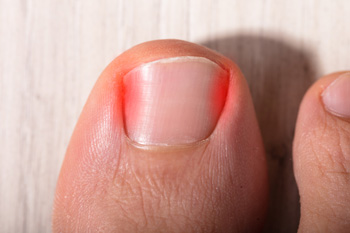Types of Ingrown Toenails

Ingrown toenails, a common foot ailment responsible for approximately 20 percent of podiatric visits, can be attributed to a variety of causes. Among these, improper nail trimming plays a significant role, as cutting nails too short or rounding them incorrectly encourages ingrowth. Wearing tight shoes or high heels that exert pressure on the toes is another prevalent cause. Trauma to the toe, such as injuries, can also contribute to the formation of an ingrown toenail. Three main types of ingrown toenails are categorized by their location on the toe. The lateral ingrown toenail, occurring most frequently, involves the side of the nail edge growing into the skin at the sides of the toe. A distal ingrown toenail can occur when the nail edge grows or curls into the skin at the end of the toe, where the top of the nail meets the skin. Proximal ingrown toenails happen when the nail grows into the skin at the base of the toe, near the cuticle area. This type is characterized by new toenail growth pushing the old nail upwards, causing it to become thick and embedded. Avoiding excessive shortcuts and wearing well-fitted footwear can significantly diminish the risk of ingrown toenails. In instances of persistent discomfort or suspected ingrown toenails, seeking professional advice from a podiatrist is suggested. Podiatrists possess the expertise to accurately diagnose the issue, determine the severity and type of ingrown toenail, and suggest suitable treatment options.
Ingrown toenails can become painful if they are not treated properly. For more information about ingrown toenails, contact one of our podiatrists of InStride Family Foot Care. Our doctors can provide the care you need to keep you pain-free and on your feet.
Ingrown Toenails
Ingrown toenails occur when a toenail grows sideways into the bed of the nail, causing pain, swelling, and possibly infection.
Causes
- Bacterial infections
- Improper nail cutting such as cutting it too short or not straight across
- Trauma to the toe, such as stubbing, which causes the nail to grow back irregularly
- Ill-fitting shoes that bunch the toes too close together
- Genetic predisposition
Prevention
Because ingrown toenails are not something found outside of shoe-wearing cultures, going barefoot as often as possible will decrease the likeliness of developing ingrown toenails. Wearing proper fitting shoes and using proper cutting techniques will also help decrease your risk of developing ingrown toenails.
Treatment
Ingrown toenails are a very treatable foot condition. In minor cases, soaking the affected area in salt or antibacterial soaps will not only help with the ingrown nail itself, but also help prevent any infections from occurring. In more severe cases, surgery is an option. In either case, speaking to your podiatrist about this condition will help you get a better understanding of specific treatment options that are right for you.
If you have any questions please feel free to contact our offices located in Concord, Charlotte, and Salisbury, NC . We offer the newest diagnostic and treatment technologies for all your foot and ankle needs.
